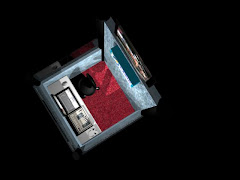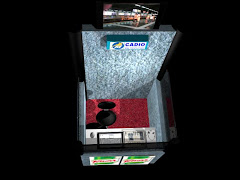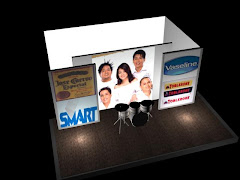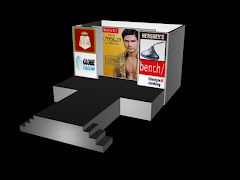CADIO came from the words “cable radio.” CADIO is pronounced “K-dio.” CADIO is a non-traditional, interactive advertising devise and a medium that has a
 booth ad system that exhibits the advertiser’s products/services to its market through signage and other forms of display; but not limited to an audiovisual performance, which is connected to its CADIO ad/program ad system. CADIO music and commercial programs are in FM radio sound format. In other words, CADIO is like an FM radio sound system that can be set up inside a broadcast coverage such as Airports, Amusement Parks, Boats & Piers, Boutiques, Buildings, Bus Terminals, Department Stores, Gas Stations, Government Places, Hardware Stores, Malls, Places of Events, Private Coverage Places, Public Places, Restaurants, Schools, Supermarkets,
booth ad system that exhibits the advertiser’s products/services to its market through signage and other forms of display; but not limited to an audiovisual performance, which is connected to its CADIO ad/program ad system. CADIO music and commercial programs are in FM radio sound format. In other words, CADIO is like an FM radio sound system that can be set up inside a broadcast coverage such as Airports, Amusement Parks, Boats & Piers, Boutiques, Buildings, Bus Terminals, Department Stores, Gas Stations, Government Places, Hardware Stores, Malls, Places of Events, Private Coverage Places, Public Places, Restaurants, Schools, Supermarkets,  Train Stations and Wholesaler-Retail Places; using cables coming from its audio-booth system hooked up to its coverage’s PA system. The broadcast coverage’s music and audio-type commercials & promotions are heard over its ceiling speakers. Most of the time, these are the speakers that are already been used for paging by customer service representatives. The short term for CADIO is MIE; Music, Information & Entertainment.
Train Stations and Wholesaler-Retail Places; using cables coming from its audio-booth system hooked up to its coverage’s PA system. The broadcast coverage’s music and audio-type commercials & promotions are heard over its ceiling speakers. Most of the time, these are the speakers that are already been used for paging by customer service representatives. The short term for CADIO is MIE; Music, Information & Entertainment.CADIOevolution
It can be traced from the following media:
- an FM radio program format
- a customer service or paging system
- a mobile sound & light system
- a special designed booth system
- an audiovisual performance
- a music television video or video ads
- a half brother of the broadcast twins, radio & TV
CADIOhistory
At first, this was called “Radio-Type and Paging Booth” by Makati Cinema Square (MCS) in the early 80’s. During that time, they thought of it as a training ground for DJs who aspire to be FM jocks and an announcement booth for the mall. Most of the DJs there became FM jocks like Sgt. Pepper (former DJ and station manager of Magic 89.9WTM), The Blade (a DJ of 103.5 K Lite), Jhonny Kismo (who became an FM jock of LA 105.9 and 89.9 WTM), Eric J and Martin D (a star DJ of WRR 101.9).
In 1989, Fair Center and Plaza Fair Sta. Cruz imitated the project and pirated Eric J, The Blade and Martin D. The style is the same with MCS but the promotional announcement is given more emphasis.
Before the innovation was transferred to Fairmart Farmers Plaza Cubao in 1993 with Tee Bone (a DJ of Yes FM 101.1), Pom Cruise (a former DJ of DM 95.5 FM) and to Martin D, Nestor Panganiban has thought of it like a real FM radio format when he was at Duty Free Philippines back in 1992. A customer asked him about the promo of Jhonnie Walker on “Scratch and Win” which had a poster in front and streamers on its selling floor. After a few minutes, many came and asked about the same thing. His co-worker John Gillardo told him that he sounded like a tape recorder. And Nestor responded, maybe it would be better to have an FM radio station type of booth within Duty Free that will announce all the promos of it through its ceiling speakers. From that time, the idea of Nestor made a great impact. So, he started studying the advertising situation of Duty Free and later proposed a project to them in 1993 called “Radio Type Booth.” Unfortunately, the proposal was turned down.
After several months the idea was developed at Shoppesville Arcade (WRS Radio Shoppesville), Greenhills with Sonny Laragan (former DJ of Love Radio DZMB) as the Station Manager. Nestor Panganiban applied there as a DJ in 1994 and was accepted and terminated after two weeks without due process. After a few years, he came back and was accepted for the second time with Benjie Tabaque (former DJ of Love Radio DZMB) and John Boncan (became an FM DJ at Hive 100.3 RJFM). The three of them worked together on the idea of “Radio Type Booth.” At that time, John Boncan named it Live-Interactive Radio (LIR) but Nestor named it “Mall Radio” which was copyrighted in 1997.
On the same year, John Boncan proposed it to Virra Mall Greenhills which was approved and implemented in 1998. John became the OIC and Nestor as one of the DJs. At that time, Nestor was given the opportunity by Richard Steele (Program Director) to work as an FM DJ in Pinoy Radio DM 95.5. Richard gave Nestor the air name “Andy Gold.” Later on Andy became a KBP member (Kapisanan ng mga Brodkaster sa Pilipinas). Then he applied as DJ in a cruise line (Star Cruise) and during the interview, an idea of Boat Radio popped into his mind and proposed it right away. The interviewer appreciated his idea and told him to make a proposal. Unfortunately, he wasn’t hired because according to them, he was overqualified.
When Virra Mall stopped its operation on its “Virra Mall Radio, Paul Diesel (former DJ of Star FM), Big Brian (a former FM DJ of K91.5 FM) and Andy Gold proposed another management to them which did not materialized.
So in November 11, 1997, Andy started expounding the two ideas in his mind, mall radio/radiovision and boat radio which became “Cable Radio.” The popularity of cable TV gave him the concept to make it “Cable Radio.” Afterwards Andy asked Big Brian his partner to make the two words into one that would create an impact. Brian told Andy, Cable + Radio is “KADIO.” Andy said, no; it should sound K-dio not KADIO. So, Andy changed the pronunciation and made it K-DIO and spelled it CADIO. Here, they started marketing it.
 In 1999, Big Brian and Andy Gold tried this innovation in three malls; Robinsons, Sta. Lucia and Metro Mall together with other DJs like Rick Stryker (a former FM DJ of Pinoy Radio DM 95.5), John Lemon (a former FM DJ of Magic 89.9 and Pinoy Radio DM 95.5), DJ Kris and Mark Detail (former FM DJ of Star FM). After the event, they ceased operating for awhile to pave way in making a research and development program.
In 1999, Big Brian and Andy Gold tried this innovation in three malls; Robinsons, Sta. Lucia and Metro Mall together with other DJs like Rick Stryker (a former FM DJ of Pinoy Radio DM 95.5), John Lemon (a former FM DJ of Magic 89.9 and Pinoy Radio DM 95.5), DJ Kris and Mark Detail (former FM DJ of Star FM). After the event, they ceased operating for awhile to pave way in making a research and development program.In 2003, Andy called-up Big Brian about the CADIO business and told him a project that he wanted to enter into. During the conversation, Big Brian thought of the idea of having an exclusive booth system. Meaning, a
 client can have its own version of a special designed booth like a hamburger (e.g. Mc Donalds). Here, Andy cultivated his experiences in PICO Arts (a contractor of booth system and special design booths) as Project Manager back in 1996 to 2000. Also, Andy tried working as a freelance host for SM supermalls & other events for 2 years, to gain more ideas on “Event management.” Then this became the start of the ironed innovation of “CADIO.” It doesn’t only play spot commercials but also gives emphasis on its booth ad system.
client can have its own version of a special designed booth like a hamburger (e.g. Mc Donalds). Here, Andy cultivated his experiences in PICO Arts (a contractor of booth system and special design booths) as Project Manager back in 1996 to 2000. Also, Andy tried working as a freelance host for SM supermalls & other events for 2 years, to gain more ideas on “Event management.” Then this became the start of the ironed innovation of “CADIO.” It doesn’t only play spot commercials but also gives emphasis on its booth ad system. 
Now, CADIO is on the go. With God on their side, Andy believes that this innovation would prevail one day. May God bless CADIO.
Last 2006, Andy rebuilt CADIO with the help of his friend Ogie Caja whose advertising company “Maya Advertising & Omnisource” has been in the industry for 23 years. Their line of business is outdoor, indoor and events advertising. They are the backbones of CADIO Advertising. So, CADIO had its event in “Auto Summit 2006,” a car show done at Festival Supermall last June 17, 2006 with Maya & Omnisource as the organizer.
Then, CADIO had an opportunity to test it in two McDonald’s stores in Metro Manila. Fortunately, CADIO passed the evaluation.
At present, CADIO is one of the suppliers of McDonald’s in CADIOcannedPragram. This is a pre-recorded music and commercial program on mp3 file format that can be played in their stores. This would sound like an FM radio inside an outlet once a customer or anybody hears the music and their promotions.



































